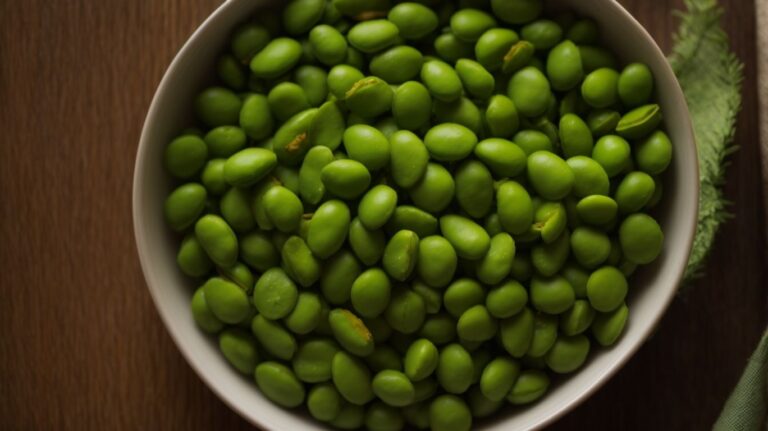How to Cook Biryani With Chicken?
Are you a fan of flavorful and aromatic dishes? If so, you must try Biryani, a popular Indian dish that is sure to tantalize your taste buds.
In this article, we will explore the origins of Biryani, the different types available, and the ingredients needed to make a delicious Chicken Biryani.
We will also walk you through the preparation and cooking process, as well as offer some tips and tricks for achieving the perfect Biryani.
Get ready to embark on a culinary journey and learn how to cook Biryani with Chicken like a pro!
Key Takeaways:
What is Biryani?
Biryani is a flavorful and aromatic dish originating from South Asia, known for its layers of tender meat, fragrant rice, and rich blend of spices.
With its roots deeply embedded in the culinary traditions of regions like Pakistan, India, and Bangladesh, biryani holds a special place in the hearts and palates of millions. This iconic dish goes beyond just food; it symbolizes celebration, togetherness, and tradition. The art of preparing biryani involves a meticulous process that demands skill and patience, from marinating the meat to layering it with parboiled rice and spices. Each region has its own unique take on biryani, whether it’s the fragrant and spicy Hyderabadi biryani, the rich and creamy Kolkata biryani, or the succulent and flavorful Dhaka biryani.”
Origin of Biryani
The origin of biryani can be traced back to the royal kitchens of Mughal India, where it was created as a decadent and flavorful dish for royalty.
During the Mughal era, the dish evolved from a simple rice and meat preparation to a rich, aromatic delicacy infused with exotic spices and fragrant herbs. The combination of slow-cooked meat, fragrant basmati rice, and a blend of traditional spices made biryani a beloved dish amongst the nobility. Over time, as the Mughal empire spread its influence across the Indian subcontinent, biryani traveled with it, adapting to local palates and culinary techniques in different regions.
Types of Biryani
There are numerous types of biryani, including the aromatic Hyderabadi biryani from India, the flavorful Pakistani biryani, and the Afghani restaurant-style biryani.
Each of these biryani varieties showcases a unique blend of spices, cooking techniques, and regional influences.
-
The Hyderabadi biryani, known for its fragrant basmati rice layered with marinated meat and infused with saffron, is a true delight for the senses.
-
Pakistani biryani, on the other hand, often features a richer and spicier flavor profile, with a generous use of aromatic spices like cumin, cardamom, and cloves.
-
For those seeking a different experience, the Afghani restaurant-style biryani offers a fusion of flavors with its use of dried fruits, nuts, and unique spices, creating a dish that is both indulgent and satisfying.
Ingredients for Biryani with Chicken
Creating a delectable biryani with chicken requires a harmonious blend of ingredients, including succulent chicken, fragrant rice, aromatic spices, and fresh vegetables.
When preparing chicken biryani, the chicken plays a crucial role in providing protein and a rich, meaty flavor to the dish. The type of rice used, such as Basmati, contributes to the perfect texture and fragrance. Aromatic spices like cumin, cardamom, and cloves infuse the biryani with a tantalizing scent and depth of taste, while fresh vegetables like onions, tomatoes, and green chilies add layers of color and a touch of freshness. Each ingredient harmonizes to create a symphony of flavors in every bite.
Chicken
Chicken is a versatile protein that serves as the heart of many biryani recipes, offering tender and flavorful meat that complements the fragrant rice and spices.
When preparing a biryani dish, selecting high-quality chicken is crucial as it impacts the overall taste and texture. Marinating the chicken with a blend of yogurt, spices, and herbs not only tenderizes the meat but also infuses it with layers of flavor.
The marination process allows the chicken to absorb the aromatic spices, creating a harmonious balance of taste.
Properly cooked marinated chicken contributes to the rich and aromatic profile of the biryani, elevating it from a simple rice dish to a culinary masterpiece.
Rice
Rice, particularly fragrant basmati rice, forms the foundation of biryani, contributing to its fluffy and aromatic texture that elevates the overall dining experience.
Choosing the right type of rice is crucial in achieving the perfect biryani. Basmati rice, with its long grains and unique aroma, is highly preferred for this flavorful dish. Properly soaking the rice before cooking helps in achieving the desired fluffy texture. Cooking techniques, such as layering the rice with meat or vegetables and slow cooking over low heat, enhance the flavors and ensure a delightful mix of spices in every bite. Different varieties of basmati rice can impact the final dish; some may provide a more delicate texture, while others offer a stronger aroma, adding depth to the overall taste.
Spices and Seasonings
Aromatic spices and seasonings play a vital role in biryani, infusing each bite with a symphony of flavors and creating the signature taste that defines this beloved dish.
The art of crafting a perfect biryani lies in the harmonious blend of spices that are carefully selected and combined to elevate every mouthful into an unforgettable culinary experience. Traditional blends like garam masala, cumin, and coriander add depth and warmth, while curry sauces such as tomato-based gravies or yogurt marinades bring tanginess and creaminess to the dish. Biryani spice mixtures often feature cloves, cardamom, and fenugreek, imparting a fragrant aroma and a complex layering of flavors that keep diners coming back for more.
Vegetables
Fresh vegetables add a delightful element of texture and flavor to biryani, creating delicious layers of taste that enhance the overall eating experience.
Regarding vegetables in biryani, the key lies in selecting the right combination that not only complements the dish but also offers a nutritional boost. Think of vibrant bell peppers, succulent mushrooms, and tender carrots that not only add color but also bring their unique flavors to the mix.
In terms of cooking methods, sautéing the vegetables before layering them in the biryani ensures they retain their crunch and individual taste profiles. This step adds a depth of flavor to the dish, making each bite a delightful medley of textures and aromas.
Other Optional Ingredients
Plus the essential components, biryani can be enhanced with optional ingredients like creamy yogurt, fragrant ghee, caramelized onions, and aromatic saffron threads.
Yogurt, often used to marinate the meat, tenderizes it and adds a tangy richness.
Ghee, a clarified butter known for its nutty flavor, lends a certain depth and richness to the overall dish.
The slow-cooked onions bring a sweet complexity and a hint of caramelization to each bite.
Saffron, with its distinct floral notes and golden hue, not only colors the rice but also imparts a subtle yet luxurious taste.
Preparation for Biryani with Chicken

Credits: Poormet.Com – Paul Jones
The preparation process for biryani with chicken involves marinating the meat, soaking the rice, and preparing the vegetables to ensure a harmonious blend of flavors and textures in the final dish.
Marinating the chicken is a crucial step to infuse it with a rich blend of spices and tenderize the meat for enhanced flavor and succulence. It involves creating a marinade mixture using yogurt, spices like cumin, coriander, and garam masala, along with ginger-garlic paste for depth of flavor.
Simultaneously, soaking the basmati rice before cooking is essential to achieve the perfect fluffy texture without the grains sticking together. Rinse the rice to remove excess starch, then soak it in water for at least 30 minutes to allow for even cooking.
Regarding preparing the vegetables for biryani, ensure they are cut uniformly to promote even cooking. Common vegetables used include potatoes, carrots, and peas, which add layers of texture and flavor to the dish when assembled.
Marinating the Chicken
Marinating the chicken is a crucial step in biryani preparation, as it allows the meat to absorb the flavors of spices, yogurt, and aromatic ingredients, creating a succulent and well-seasoned dish.
Regarding marinating chicken for biryani, there are various popular recipes used by chefs worldwide. One popular marinade includes a blend of ginger, garlic, and green chili paste mixed with yogurt and a medley of spices like turmeric, cumin, and coriander. The chicken pieces are often marinated for at least 4-6 hours or overnight to ensure the flavors penetrate the meat thoroughly. To enhance tenderness, adding a splash of lemon juice or raw papaya paste can be helpful due to their natural meat-tenderizing properties.
Soaking the Rice
Soaking the rice is a critical step in biryani preparation, as it helps achieve the perfect texture and ensures each grain is infused with the aromatic flavors of spices and seasonings.
When soaking the rice for biryani, it is key to use the right water-to-rice ratio to prevent the grains from becoming too mushy or too firm. The ideal ratio is typically around 1:2, ensuring that the rice absorbs just the right amount of water without becoming soggy. This process not only softens the grains but also helps them hold their shape during the cooking process.
- Soaking rice before cooking allows the grains to expand and elongate uniformly, resulting in a more visually appealing dish with each grain distinct and separate.
- Soaking also aids in reducing the overall cooking time, as the grains partially cook during the soaking period, ensuring that they require less time on the heat to reach the perfect doneness.
Preparing the Vegetables
Preparing the vegetables for biryani involves careful layering and cooking techniques to ensure they retain their texture and flavors while adding depth to the overall dish.
One common method is to sauté the vegetables separately with spices like cumin, coriander, and garam masala to enhance their individual tastes before layering them into the rice. Popular vegetable choices for biryani include carrots, peas, potatoes, and bell peppers, which provide a colorful and nutritious contrast to the rice. These vegetables can be parboiled or partially cooked to ensure they soften perfectly during the final cooking stage. This process not only adds visual appeal but also boosts the nutritional value of the biryani.
Cooking Biryani with Chicken
Cooking biryani with chicken involves delicate layering of ingredients, precise cooking techniques, and protein management to achieve a dish that is both tender and bursting with flavor.
Regarding layering, a common method is to alternate the rice and chicken layers, ensuring an even distribution of flavors throughout the dish. The stovetop method involves cooking the marinated chicken with spices and aromatics, then adding partially boiled rice before allowing it to steam until fully cooked.
Alternatively, the oven method entails assembling the biryani in a baking dish, covering it with foil, and baking it at a moderate temperature until the chicken is tender and the rice is fluffy.
Protein considerations are crucial in biryani cooking, as the chicken must be cooked just right to retain its juiciness and flavor. It’s essential to marinate the chicken properly to enhance its taste and ensure it cooks evenly with the rice.
Layering the Ingredients
Layering the ingredients in biryani is a meticulous process that involves alternating between rice, meat, and vegetables to create a visually appealing and flavorful dish.
One of the key techniques in perfecting the art of layering biryani is to ensure each layer is packed with vibrant flavors that complement each other harmoniously. To achieve this, each component such as marinated meat, aromatic spices, fried onions, and saffron-infused rice must be thoughtfully arranged in a precise sequence.
Creating distinct layers not only enhances the presentation but also ensures the even distribution of flavors throughout the dish. This can be accomplished by gently pressing down each layer before adding the next, allowing the ingredients to meld together while retaining their individual tastes.
Cooking on Stove-top
Cooking biryani on the stovetop requires a balance of heat and time to ensure the rice is fluffy, the chicken is tender, and the flavors are perfectly melded together.
When preparing biryani on the stovetop, it’s crucial to start with the right temperature setting. Begin by cooking the marinated chicken on medium-high heat to seal in the juices and flavors. Once the chicken is browned, remove it from the pot before moving on to the rice.
For the rice, lower the heat to a gentle simmer to avoid overcooking or burning. Layer the partially cooked rice over the chicken and allow it to steam together on low heat. This gradual cooking process ensures each grain of rice is distinct yet fully cooked.
Cooking in an Oven
Baking biryani in an oven offers a different cooking experience, allowing the dish to develop a distinct taste and texture while ensuring even cooking and flavor infusion.
When biryani is baked in an oven, the heat circulates evenly around the dish, ensuring that each grain of rice absorbs the rich flavors of the spices and tender meat. This cooking method also allows for a gradual melding of aromas, resulting in a harmonious blend of spices and ingredients. The slow cooking process in the oven helps tenderize the meat, infusing it with succulent flavors and retaining moisture.
The aromatic steam generated within the closed oven further intensifies the flavors, creating a fragrant and enticing aroma that permeates the entire dish. This unique cooking technique transforms the biryani into a culinary masterpiece, with each bite offering a burst of flavors that can only be achieved through the art of oven baking.
Serving and Garnishing Biryani with Chicken
Serving biryani with chicken involves presenting the dish with creative flair, offering various garnishing options and serving suggestions that elevate the dining experience.
One way to enhance the visual appeal of your chicken biryani is to top it off with a generous sprinkling of golden-fried onions that adds a delightful crunch and rich flavor. Consider garnishing with a vibrant assortment of fresh cilantro leaves and juicy lemon wedges placed strategically on top of the bed of fragrant basmati rice and succulent chicken pieces.
For a more sophisticated presentation, serve your chicken biryani in elegant serving bowls lined with edible rose petals and accompanied by small bowls of mint raita, tangy pickle, and crunchy papadums. This not only creates a visually stunning display but also allows your guests to customize their dishes according to their preference.
Serving Suggestions
When serving chicken biryani, consider pairing it with refreshing minted yogurt, crispy onions, or a side of spicy curry sauce to enhance the overall dining experience.
Imagine the tender, aromatic chicken pieces delicately cooked with fragrant Basmati rice and a blend of signature spices, creating a vibrant and flavorful dish.
The coolness of the minted yogurt perfectly balances the warmth of the biryani, providing a contrast of textures and temperatures. Crispy onions add a delightful crunch, while the curry sauce brings a bold, tangy kick to every bite.
These accompaniments not only add layers of taste but also offer a variety of mouthwatering sensations, making each forkful a culinary delight.
Garnishing Options
Garnishing chicken biryani with crispy onions, aromatic spices, and fresh coriander adds a final touch of flavor and visual appeal, elevating the dish to a culinary masterpiece.
A sprinkle of golden fried garlic atop the biryani infuses a delightful crunch and a burst of savory warmth into every bite. This simple yet impactful garnish not only enhances the overall texture but also introduces a depth of flavor that complements the rich, aromatic notes of the dish. Pairing the biryani with a dollop of cool, creamy yogurt raita seasoned with zesty mint and tangy cumin further balances the spiciness and richness, creating a harmonious culinary experience.
Tips and Tricks for Making the Perfect Biryani with Chicken

Credits: Poormet.Com – Ryan Hall
Achieving the perfect chicken biryani requires attention to detail and a mastery of key techniques, along with creative tips and tricks to enhance the dish’s flavors and textures.
One crucial aspect of preparing a flavorful chicken biryani is the marination process. To infuse the meat with flavor and tenderness, consider marinating the chicken in a mixture of yogurt, ginger garlic paste, and aromatic spices like garam masala. Layering the marinated chicken with partially cooked basmati rice, saffron-infused milk, and fried onions adds depth and richness to the dish.
Choosing the Right Chicken
Selecting high-quality chicken with the right balance of fat and protein is essential for ensuring tender and flavorful meat in chicken biryani, enhancing the overall dining experience.
Regarding marination, giving the chicken enough time to soak up a blend of yogurt, spices, and aromatics such as ginger and garlic is crucial. This process not only adds depth and complexity to the flavor but also helps in tenderizing the meat. Consider the protein content of the cuts you choose, as different parts offer varying levels of tenderness and juiciness.
The breasts, being leaner, may benefit from a longer marination duration to keep them moist during cooking, while the thighs and drumsticks, with slightly higher fat content, can handle bolder, spicier flavors. Balancing these factors ensures that each bite of the biryani is rich, succulent, and bursting with aromatic undertones.
Getting the Rice Consistency Right
Achieving the perfect consistency of rice in chicken biryani requires proper soaking, accurate water ratios, and an understanding of the impact of using aged basmati rice for optimal texture and flavor.
Soaking the basmati rice for at least 30 minutes before cooking helps each grain absorb water evenly, leading to a uniform texture. When measuring water, a common rule is using a 1:1.5 ratio of rice to water for biryani. This ensures that the rice cooks to perfection without becoming mushy or sticking together. Aged basmati rice, known for its elongated grains and fragrant aroma, brings out the best in biryani dishes, creating a delightful sensory experience.
Adjusting Spice Levels
Tailoring the spice levels in chicken biryani allows for a personalized dining experience, where adjustments can be made to suit individual preferences for mild, medium, or hot flavors.
Regarding adjusting the spiciness of biryani, there are various techniques that can be employed to attain the perfect balance of flavors. One approach is to create a custom spice blend that caters to your taste buds, combining ingredients like cumin, coriander, and garam masala in proportions that align with your desired spice level.
For those who prefer a milder taste, reducing the amount of red chili powder or omitting green chilies can tone down the heat without compromising on the aromatic essence of the dish. On the other hand, individuals inclined towards fiery flavors can enhance the spiciness by adding additional red chili flakes or a dash of cayenne pepper.
Conclusion

Credits: Poormet.Com – Lawrence Miller
In conclusion, chicken biryani stands as a culinary masterpiece that embodies the rich flavors and culinary traditions of Pakistan and India, offering a tantalizing blend of fragrant rice, tender chicken, and aromatic spices.
This renowned dish not only symbolizes the diverse cultural heritage of the Indian subcontinent but also reflects the art of blending traditional ingredients in a harmonious way. The succulent pieces of chicken marinated in flavorful spices, combined with long-grain basmati rice deeply infused with saffron, create a symphony of tastes that dance on the palate.
Every region adds its unique touch to this beloved dish, resulting in variations that range from the spicier Hyderabadi biryani to the milder Lucknowi version, all of which promise a delightful feast for the senses.
Frequently Asked Questions
What ingredients are needed to cook biryani with chicken?
To make biryani with chicken, you will need chicken, basmati rice, spices, yogurt, onions, tomatoes, ginger, garlic, and oil.
Can I use boneless chicken to cook biryani?
Yes, you can use boneless chicken to cook biryani. However, using bone-in pieces adds more flavor to the dish.
What is the best method to cook biryani with chicken?
The most traditional method is to cook biryani with chicken in a large pot over a slow flame, known as “dum” cooking. This allows the flavors to blend and the chicken to fully cook in its own steam.
Can I substitute chicken with other meats in biryani?
Yes, you can substitute chicken with mutton, beef, or even vegetables, depending on your preference. Each type of protein will require different cooking times, so be sure to adjust accordingly.
How long does it take to cook biryani with chicken?
The cooking time for biryani with chicken can range from 45 minutes to 2 hours, depending on the method and quantity. It is important to not rush the cooking process and allow the flavors to develop.
Do I need to marinate the chicken before cooking biryani?
Marinating the chicken in yogurt and spices is a crucial step in making flavorful biryani. It is recommended to marinate the chicken for at least 1 hour, but overnight is even better.






